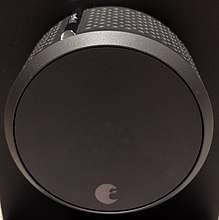Smart lock
A smart lock is an electromechanical lock which is designed to perform locking and unlocking operations on a door when it receives such instructions from an authorized device using a wireless protocol and a cryptographic key to execute the authorization process. It also monitors access and sends alerts for the different events it monitors and some other critical events related to the status of the device. Smart locks can be considered part of a smart home.[1]

Most smart locks are installed on mechanical locks (simple types of locks, including deadbolts) and they physically upgrade the ordinary lock. Recently, smart locking controllers have also appeared at the market.
Smart locks, like the traditional locks, need two main parts to work: the lock and the key. In the case of these electronic locks, the key is not a physical key but a smartphone or a special key fob configured explicitly for this purpose which wirelessly performs the authentication needed to automatically unlock the door.
Smart locks allow users to grant access to a third party by means of a virtual key. This key can be sent to the recipient smartphone over standard messaging protocols such as e-mail or SMS. Once this key is received the recipient will be able to unlock the smart lock during the time previously specified by the sender.
Smart locks are able to grant or deny access remotely via a mobile app. Certain smart locks include a built-in Wi-Fi connection that allows for monitoring features such as access notifications or cameras to show the person requesting access.[2] Some smart locks work with a smart doorbell to allow the user to see who and when someone is at a door.
Smart locks may use Bluetooth Low Energy and SSL to communicate, encrypting communications using 128/256-bit AES.[3]
Security
Due to the inherent complexity of digital and wireless technologies, it can be difficult for the end user to confirm or refute the security claims of various product offerings on the market.[4] The devices may also gather personal information; representations by the vendors involved concerning the care and handling of this information is also difficult to verify by the end user.[4]
References
- "Your Door Is About to Get Clever: 5 Smart Locks Compared". Wired. 2013-06-19.
- "Goji's Smart Lock snaps pictures, welcomes you by name". Engadget. 2013-06-04.
- "Smart Locks, Secure or Just Dumb?". Gizmodo. 2013-06-05.
- Cox, Kate (7 April 2020). "Easy-to-pick "smart" locks gush personal data, FTC finds". arstechnica.com. Ars Technica. Retrieved 8 April 2020.